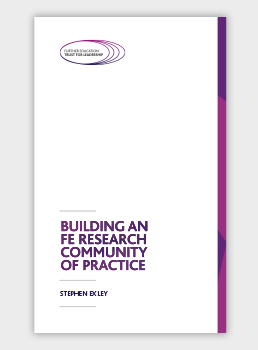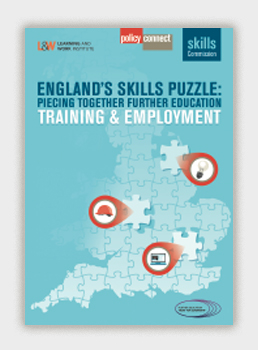
A disaster waiting to happen
The collapse in apprenticeship starts was as predictable as it is disappointing. We need a full and open debate to ensure it doesn’t happen again, writes Mark Dawe
One can only imagine the Sir Humphrey-style conversations that took place between ministers and officials following the 61 per cent collapse in apprenticeship starts since May: ‘Not quite two-thirds though, is it, minister?’ or, perhaps, ‘Don’t worry, minister, we predicted this devastating fall – if we keep doing nothing, our model says we will be alright and hit the target’. Has anyone seen the model and the full assumptions? I don’t think we are going to be okay unless action is taken and taken quickly.
We are happy to recognise that even though the figures are dire, there are some silver linings for providers, such as a more promising outlook for starts with large levy-paying employers. Nevertheless, as the AELP commented when the figures were released, the collapse in numbers was all too predictable. It has, after all, been 12 months since MPs on the Public Accounts Committee warned officials from the Department for Education that starts would crash in their constituencies because they had few or no levy payers in them.
The design of the system wasn’t changed between that October 2016 session and the start of the levy. Consequently, we saw starts fall from 113,000 in May-July 2016 to 43,600 for the same period this year. According to this month’s statistical first release, 18,500 (or 42 per cent per cent) of starts since May of this year were with levy payers and unless there is a change in policy, the proportion of starts with levy payers is very likely to increase and for existing staff at higher levels.
In response to the numbers, it is important to point out that it is not just the funding part of the apprenticeship reforms that is responsible for the drop. The switch-over from frameworks to standards has also been a factor as many employers have held back on starts until they know that a standard has been approved with the proper assessment arrangements in place.
The understandable drive to improve quality alongside the increase in starts towards the 3 million target has unfortunately included the misguided notion that quality will be better if 20 per cent of all apprenticeship training is done off the job over a minimum of 12 months. This arbitrary equivalent of a day release every week belongs to another era. It offers no guarantee of quality learning for the apprentice and Ofsted is not interested in inspecting it as such. Furthermore, there are many examples of on-the-job training that are far superior to the off-the-job equivalent. Employers in both the private and public sectors, including NHS Trusts, are pushing back against what is just an Education and Skills Funding Agency funding rule. Some say that they can’t afford the non-productive time or the cost of staff backfill. Even worse, the rule is acting as barrier against social mobility because it is reducing the number of opportunities for young people to start an apprenticeship at Level 2 with the promise of progression.
Like it or not, the apprenticeship reforms are employer-driven and paying the levy means that employers are very much entitled to have a big say on what an apprenticeship should look like. Therefore, it is AELP’s view that the employer-led Trailblazer groups should be given the responsibility to decide what percentage of off-the-job training is appropriate for their particular sector and at each level. Indeed, there may be different approaches depending on the employer, employment and setting for each apprentice.
The huge drop in non-levy starts can also be attributed to resistance from small and medium-sized enterprises to the new co-investment requirement and the original botched procurement exercise for providers to bid for non-levy funding disrupting the supply side. We now know too that the government’s thinking on predicted starts was originally based on a bizarre set of assumptions which would never have stood up if they had been run past experienced and expert stakeholders first. The government must do more to consult with employers and providers in finding an approach that works.
As a matter of urgency, to stop further sharp falls in starts, the government needs to:
- restore incentives for employers to recruit young apprentices;
- halt the decline in apprenticeship opportunities at Level 2 and Level 3;
- guarantee a minimum £1 billion budget for the apprenticeships of non-levy paying SMEs;
- allow flexibility between on- and off-the-job training.
We then need a full and open debate involving all stakeholders, including sector leaders, on the design of the funding model which will be used for apprenticeships after the non-levy paying employers join the levy payers on the digital Apprenticeship Service in April 2019. Let’s not stumble into another catastrophe in a programme which has so many positives.
Mark Dawe is Chief Executive of the Association of Employment and Learning Providers





















































































I fully agree with this. We are a hair and beauty apprenticeship provider delivering to 100% non levy employers who are being switched off taking on apprentices. The 20% off the job training will definitely stop progression to L3 if it hasn’t already at L2.
What’s up colleagues, pleasant paragraph and
pleasant urging commented at this place, I am genuinely enjoying by these.
Hello ! I am the one who writes posts on these topics baccaratsite I would like to write an article based on your article. When can I ask for a review?
What’s up, just wanted to tell you, I enjoyed this blog post.
It was funny. Keep on posting!
Everything is very open with a very clear explanation of the challenges.
It was truly informative. Your website is very helpful.
Many thanks for sharing!
Write more, thats all I have to say. Literally, it seems as though you relied on the video to make your
point. You clearly know what youre talking
about, why throw away your intelligence on just posting videos to your blog when you could be giving us something informative to read?
hey there and thank you for your info –
I have certainly picked up something new from right here.
I did however expertise several technical issues using this website, as I experienced to reload the website a lot of
times previous to I could get it to load properly.
I had been wondering if your web hosting is
OK? Not that I’m complaining, but slow loading instances times will
sometimes affect your placement in google and could damage
your high-quality score if advertising and marketing with Adwords.
Anyway I am adding this RSS to my e-mail and could look
out for a lot more of your respective intriguing content.
Ensure that you update this again soon.
Right here is the right web site for anyone who wishes
to find out about this topic. You know a whole lot its almost
hard to argue with you (not that I really would want to…HaHa).
You certainly put a fresh spin on a topic that’s been discussed for many years.
Great stuff, just excellent!
Hi I am so delighted I found your website, I really found you by mistake, while I was
researching on Google for something else, Anyhow I am here now and
would just like to say thank you for a remarkable post and a all round entertaining blog (I
also love the theme/design), I don’t have time to look
over it all at the moment but I have bookmarked it and also added your RSS feeds, so when I have time
I will be back to read more, Please do keep up the superb
work.
Very nice article. I definitely appreciate this website. Keep writing!
Thanks for one’s marvelous posting! I certainly enjoyed
reading it, you could be a great author. I will ensure that I bookmark your blog
and definitely will come back from now on. I want to encourage you to definitely
continue your great writing, have a nice holiday weekend!
Generally I do not read article on blogs,
but I wish to say that this write-up very pressured
me to take a look at and do so! Your writing style has been surprised me.
Thank you, very nice article.
Very great post. I just stumbled upon your weblog and wished to say that I have really loved browsing
your blog posts. In any case I’ll be subscribing in your rss feed and I am hoping you write
once more soon!
I all the time used to read post in news papers
but now as I am a user of web so from now I am
using net for content, thanks to web.
Hi there to all, it’s really a nice for me to go to see this web page,
it includes helpful Information.
I blog frequently and I truly thank you for your information. The article has really peaked my interest.
I will book mark your blog and keep checking for new details about once per week.
I opted in for your RSS feed as well.
It’s an amazing post in favor of all the web viewers; they will get
benefit from it I am sure.
Excellent pieces. Keep writing such kind of info on your
site. Im really impressed by it.
Hey there, You’ve performed a fantastic job. I’ll certainly digg it and personally suggest to
my friends. I’m sure they’ll be benefited from this site.
It’s a shame you don’t have a donate button!
I’d certainly donate to this excellent blog! I guess for now i’ll settle for book-marking and adding your RSS
feed to my Google account. I look forward to brand new updates and will share
this site with my Facebook group. Chat soon!
hello there and thank you for your info – I have definitely picked up something new
from right here. I did however expertise
some technical points using this web site, as I experienced to reload the
web site a lot of times previous to I could get
it to load properly. I had been wondering if your web host is OK?
Not that I’m complaining, but sluggish loading instances times will very
frequently affect your placement in google and could damage your high-quality
score if ads and marketing with Adwords. Anyway I am adding this RSS to my email and can look out for a lot more of your respective exciting content.
Ensure that you update this again soon.
great issues altogether, you simply won a brand new reader.
What would you recommend about your publish that you simply made some days ago?
Any certain?
Good answers in return of this question with genuine arguments and explaining all about that.
Have you ever considered creating an ebook or guest authoring on other blogs?
I have a blog centered on the same ideas you discuss and would really like to have you share some stories/information. I know my readers
would value your work. If you’re even remotely interested, feel free to send me an e-mail.
Exceptional post but I was wondering if you could write
a litte more on this subject? I’d be very grateful if you could elaborate a little bit more.
Thanks!
When I originally commented I seem to have clicked the -Notify me when new comments are added- checkbox
and from now on whenever a comment is added I get 4 emails
with the exact same comment. Perhaps there is a means you can remove me from
that service? Cheers!
Hi there I am so excited I found your blog page, I really found you by accident, while I was looking
on Aol for something else, Nonetheless I am here now and would just like to say many thanks for a tremendous post and a all round enjoyable blog (I also love the theme/design),
I don’t have time to browse it all at the minute but I have book-marked it
and also added in your RSS feeds, so when I have time I will be back to read a great deal more, Please
do keep up the excellent job.
Heya! I’m at work browsing your blog from my
new iphone 3gs! Just wanted to say I love reading through your blog and look forward to all your posts!
Keep up the fantastic work!
Good shout.
Nice
Nice
thcv gummies area 52
weed pen area 52
cbd gummies for sleep area 52
thc gummies
liquid thc area 52
microdosing edibles area 52
thc gummies for pain area 52
thc vape hybrid area 52
best indica thc weed pens area 52
mood gummies area 52
best sativa thc edibles area 52
best amanita edibles area 52
2 gram carts area 52
best thca flower area 52
live resin carts area 52
thc gummies for anxiety area 52
AS
sativa vape area 52
live rosin gummies area 52
best pre rolls area 52
LJ
magic mushrooms for sale area 52
indica gummies area 52